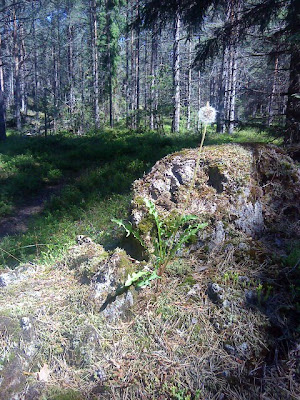What is the typical Estonian cuisine? I often get asked upon accidentally dropping my place of origin, a tiny country an hour's ferry drive from
'The essence of Estonian cuisine is in its numerous, small islands, which, because of their remoteness have been less affected by centuries of occupation: sturdy vegetables, plentiful fish, forest goods:
Roman Zaštšerinski explains to me, an award-winning chef who has recently opened his own restaurant 'Moon' (pronounced as mo-hon, meaning a poppy in Estonian) in a humble but hip area of Kalamaja, right next to
 Recently opened Moon restaurant:
Recently opened Moon restaurant:
(from left to right) Igor Andrejev (chef), Roman (chef and owner) and Jana Zaštšerinski (owner and sommelier)
Roman and I, together with his wife, Jana Zaštšerinski, the co-owner and the laid-back sommelier, are sitting in one of Moon's rooms, a few minutes before it opens for a busy lunch service. It is hot and blindly sunny outside, and the airy room full of light wood feels even lighter; in fact, the place feels like a good gastro-pub, with its sturdy furniture and un-fussy cutlery. Both owners are impossibly young, already with an impressive track record (Roman's been named the best Chef by Gastronomy Society of Estonia, and is a chef-de-cuisine of one of the top
I am curious what they think about the 'real' Estonian food - is it disappearing with Estonian burgeoning encounter with the EU and people's slow but steady financial independence?
Jana animatedly reassures me that on the contrary, a lot of young people are increasingly interested in grow-your-own, dachas, shopping at farmers' markets. In fact, she half-smiles, it is more her mother's generation that scorned the markets - those caught in between the Soviet collectivism and modern-day yearning to return to 'one's roots'. Jana dreamily tells me how she remembers having to collect podorozniki (weed with lots of healing properties, growing in abundance by the side of roads) as part of her summer school tasks. She is planning to get Moon's staff to do similar things whilst the restaurant is closed in July...

What did they want to achieve with opening their own place, I wonder, after all it is so much simpler than Roman's previous haute-couture ventures.
'It's all about the ingredients and simplicity':
Roman explains. Moon uses a heck of a lot of semi-obscure Estonian berries (such as chokeberry, lingonberry) and they work with several local producers on sourcing produce. Fish comes from the fish market literally down the road. To a foodie Brit this sounds so familiar, but at the same time my heart was melting under Estonian's curiously hot sun - re-connecting people with food that has history does a better job than any commission on ethnic diversity...
Who comes here? Roman explains that at the very beginning it was mainly Estonians who were frequenting Moon, but these days it is both Russians and Estonians, as well a few wondering Finns and Swedes.
As the restaurant started to fill in for lunch, I saw quite a few robust young men, on their own or accompanied by pretty but professional looking young women.
Men who earn enough to afford a nice lunch out, but not too much to have to bear a suit and a tie.The class is a better unifier in modern
To me Roman and Jana are the symbols of this who-gives- the fuck- about-your-'nationality' attitude: Roman being a Rus, Jana being Estonian, speaking effortlessly both languages (and English of course), transcending any seeming language and nationality barriers blindly - in a good way. The banter in the restaurant amongst the owners, their funky young stuff and the punters is an intermingle of languages.
So what about the food?
It is wholesome, inventive, young-spirited. It's good.
Roman with his worldy experience, manages to combine European influences with Estonian eccentricities, resulting in such dishes such as Orsotto (risotto made out of barley, grown widely in
Orsotto with roasted beetroot and goat cheese
There are a few squarely Russian dishes on the menu, with meaningful tweaks; such as these pickled (salted marinade, with just a bit of sugar) cucumbers, served with sourcream and honey. A revelation.

More classic offerings are the Siberian pelmeni, dumplings served in wild mushroom bouillon - delicate (a young pigglet?) pork flavour with intense aroma of mushrooms, and Borsch made with beef stock - that NamiNami specifically recommended to me. I would have loved to try Boeuf a la tartar with spicy Adzika (hot Georgian paste).
Desserts also borrow from native lands, with such creations as Napoleon (classic Soviet mille-feuille cake) with lingonberry's jam. I went for an alcoholic closing - home-made liqueur from black chokeberry (Aronia). Dark, strong, yet refreshing.
Go.
Moon Kohvik. address Võrgu 3,
A 3-course dinner for two, including drinks and service is around EEK600-700, or £35.






No comments:
Post a Comment